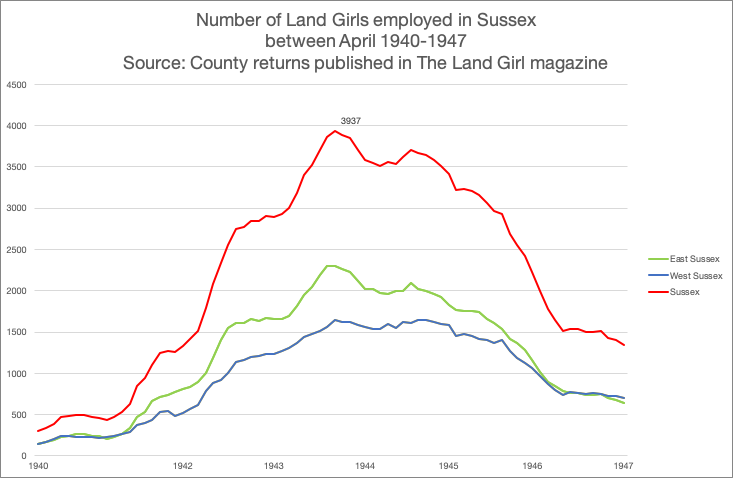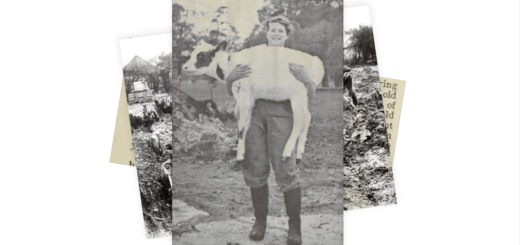May Snapshot in 5: Sussex
April’s post features the work of the WLA in Sussex (both East and West Sussex). Together, both counties employed just under 4,000 Land Girls from 1939 to 1950. If you were a Land Girl who worked in East or West Sussex, or know one who was, then drop me an e-mail.
1. Land Girls prepare rat poison at a Sussex farm, 1942.

This photograph shows Eileen Barry (left) and Audrey Willis (right) preparing rat poison as part of their training as Land Girls. Government propaganda from the period led with the slogan: ‘Kill That Rat: It’s Doing Hitler’s Work‘. Land Girls often travelled around different farms in an area, laying sugared bait and clearing away the dead rats.
You can see other photos from this shoot here. And if you’re interested in browsing more archive material on the Women’s Land Army rat catching efforts, click here.
Source: Imperial War Museum, D 11221
2. A letter from West Sussex Land Girl D.E.Runacles reflecting on her transformation as a Land Girl, 1941.

In this letter addressed to the Editor of The Land Girl, Miss D Runacles describes the feeling of terror and bewilderment she felt at the beginning of her service. Although she felt ‘she should never make a Land Girl’, she reflects how three months later, she could milk 12 cows twice a day and ride a horse with a cart. She ends her letter advising that new recruits should: ‘Stick it just a little while longer and you will begin to love it’. Margaret Pyke, editor of The Land Girl, would have chosen to publish this letter to encourage other women who might be challenged by their new agricultural tasks to persist with their efforts.
Source: The Land Girl, July 1941, p. 7
3. British Pathé film featuring Daphne, mobile milk maid, 1946
This video shows Land Girl Daphne Perry riding her bicycle through the countryside to milk cows. Her farm work allowed regular farm milkers to have a valuable day off, which the commentator cites as one of the reasons why those did not want to continue in farming. The mobile milk maid scheme was paid for by the War Agricultural Committee. According to the commentator, one of the benefits of the scheme to Land Girls was the variety of work on different farms, working with a range of cows.
Source: British Pathé
4. Office staff working in Balcombe Place

The headquarters of the Women’s Land Army was based in Honarary Director Lady Denman’s home Balcombe Place, in Haywards Heath. Referred to as the ‘big, pumping heart at the centre’ of the WLA by Vita Sackville-West, the Tudor mansion was set in 3,000 acres of land. Here we see office workers carrying out vital administrative work which underpinned the organisation of the Women’s Land Army throughout the country.
You can find out more about Balcombe Place here.
Source: Carol Twinch, ‘Women on the Land: Their Story During Two World Wars’, p. 68.
Originally from the collection of Vita Sackville-West.
5. Map of Sussex’s wartime agricultural contributions, sold by WLA County Secretaries.

This beautiful map was drawn by cartographer Mr Ernest Clegg and was one of the first in the series to raise money for the Women’s Land Army Benevolent Fund. The map shows what crops were grown in different parts of the county, as well as details on how the land was used during wartime. Note how it draws attention to how the county doubled its arable acreage during the war. Unlike other maps in the series (such as the Norfolk), the map was dedicated to Honorary Director Lady Gertrude Denman, whose coat of arms can be seen in the right-hand corner.
Maps such as these were lent to each of counties for exhibition before they were then put on sale. If Land Girls wanted a copy, they could order them through their County Secretaries. According to The Land Girl in August 1946, a single map cost 10/6d, and helped to raise money for the WLA Benevolent Fund. Clegg also produced maps for Norfolk, Kent, Cambridgeshire, amongst others.
If you’d like to read more about the history of these maps, visit Barron Maps which provide a useful history. You can click here to see a larger version of the map, photographed from Amy de la Haye’s book ‘Land Girls Cinderellas of the Soil’.
Source: Barron Maps
Further information on the WLA in Sussex
Numbers

Land Girls employed in Sussex from April 1940 to 1947, calculated from the returns published in The Land Girl magazine. In April 1940, Sussex employed just 297 Land Girls. By September 1943, 3937 Land Girls worked in the county.
Staff members
East Sussex
Chairman: The Countess De La Warr, Fishers Gate, Withyham
Secretary: Mrs R. Lowman, Cockhaise, Lindfield, Sussex
West Sussex
Chairman: The Hon Mrs Burrell, Church Farm, North Shipley, Horsham
Secretary: Miss Forbes Adam, 8 Worthing Road, Horsham
Memoirs
Violet Crowley, Over My Shoulder (Ilfracombe: Arthur H.Stockwell Ltd, 1985).
Josephine Duggan-Rees, Corduroy Days: A Portrait Of Life In The Women’s Land Army (Bognor Regis: Woodfield Publishing, 2000).
Gwenda Morgan, The Diary Of A Land Girl, 1939 -1945 (Risbury: Whittington Press, 2002).
Find out more
Did you or a member of family work in Sussex as a Land Girl? If so, then get in touch.
Interested in seeing more material relating to the WLA in Sussex? Click here or take a look at the archive material below.


